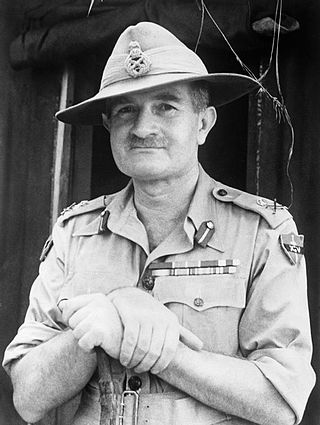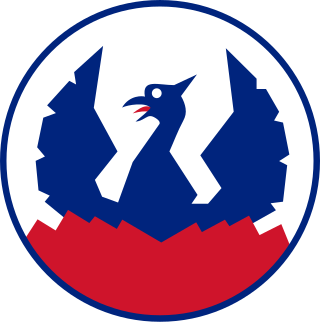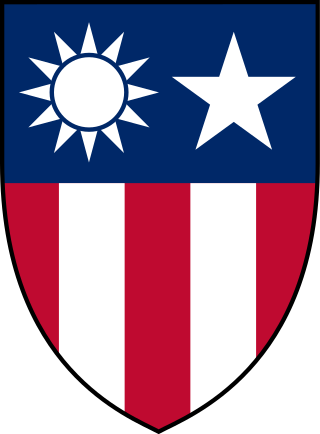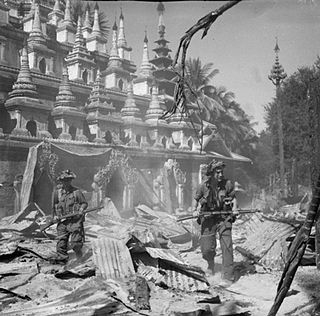
Joseph Warren "Vinegar Joe" Stilwell was a United States Army general who served in the China Burma India Theater during World War II. An early American popular hero of the war for leading a column walking out of Burma pursued by the victorious Imperial Japanese Armed Forces, his implacable demands for units debilitated by disease to be sent into heavy combat resulted in Merrill's Marauders becoming disenchanted with him. Infuriated by the 1944 fall of Changsha to a Japanese offensive, Stilwell threatened Chinese Nationalist leader Chiang Kai-shek that lend-lease aid to China would be cut off, which led Ambassador Patrick J. Hurley to decide Stilwell had to be replaced. Chiang had been intent on keeping lend-lease supplies to fight the Chinese Communist Party, but Stilwell had been obeying his instructions to get the CCP and the Kuomintang to co-operate against Japan.

The Cairo Conference also known as the First Cairo Conference, was one of the 14 summit meetings during World War II that occurred on November 22–26, 1943. The Conference was held at Cairo in Egypt between the United Kingdom, China, and the United States. It outlined the Allied position against the Empire of Japan during World War II and made decisions about postwar Asia. The conference was attended by British Prime Minister Winston Churchill, Chairman of the Chinese National Government and Chairman of the Military Commission of the National Government Chiang Kai-shek, and US President Franklin D. Roosevelt.
Supreme Allied Commander is the title held by the most senior commander within certain multinational military alliances. It originated as a term used by the Allies during World War I, and is currently used only within NATO for Supreme Allied Commander Europe and Supreme Allied Commander Transformation.

Field Marshal William Joseph Slim, 1st Viscount Slim,, usually known as Bill Slim, was a British military commander and the 13th Governor-General of Australia.

The British Fourteenth Army was a multi-national force comprising units from Commonwealth countries during the Second World War. As well as British Army units, many of its units were from the Indian Army and there were also significant contributions from British Army's West and East African divisions. It was often referred to as the "Forgotten Army" because its operations in the Burma Campaign were overlooked by the contemporary press, and remained more obscure than those of the corresponding formations in Europe for long after the war. For most of the Army's existence, it was commanded by Lieutenant-General William Slim.

The Northern Combat Area Command (NCAC) was a subcommand of the Allied South East Asia Command (SEAC) during World War II. It controlled Allied ground operations in northern Burma. For most of its existence, NCAC was commanded by United States Army General Joseph "Vinegar Joe" Stilwell. In 1945 after Stilwell was recalled, his deputy, Lieutenant General Daniel Sultan, was promoted to and assumed command.

South East Asia Command (SEAC) was the body set up to be in overall charge of Allied operations in the South-East Asian Theatre during the Second World War. It was headquartered at the Kandy, Sri Lanka home of Major General Denis Price.

The Burma campaign was a series of battles fought in the British colony of Burma. It was part of the South-East Asian theatre of World War II and primarily involved forces of the Allies against the invading forces of the Empire of Japan. Imperial Japan was supported by the Thai Phayap Army, as well as two collaborationist independence movements and armies. The first of these was the Burma Independence Army, which spearheaded the initial attacks against the country. The Indian National Army, led by Subhas C. Bose of the Free India movement, also collaborated with Imperial Japan, especially during Operation U-Go in 1944. Nominally independent puppet states were established in the conquered areas and some territories were annexed by Thailand. In 1942 and 1943, the international Allied force in British India launched several failed offensives to retake lost territories. Fighting intensified in 1944, and British Empire forces peaked at around 1 million land and air forces. These forces were drawn primarily from British India, with British Army forces, 100,000 East and West African colonial troops, and smaller numbers of land and air forces from several other Dominions and Colonies. These additional forces allowed the Allied recapture of Burma in 1945.

The South-East Asian Theatre of World War II consisted of the campaigns of the Pacific War in the Philippines, Thailand, Indonesia, Indochina, Burma, India, Malaya and Singapore between 1941 to 1945.

China Burma India Theater (CBI) was the United States military designation during World War II for the China and Southeast Asian or India–Burma (IBT) theaters. Operational command of Allied forces in the CBI was officially the responsibility of the Supreme Commanders for South East Asia or China. However, US forces in practice were usually overseen by General Joseph Stilwell, the Deputy Allied Commander in China; the term "CBI" was significant in logistical, material and personnel matters; it was and is commonly used within the US for these theaters.

The efficient running of the North-east Indian railways during World War II became critical to the success of the Allied war effort in the South-East Asian Theatre.

Lieutenant-General Sir Oliver William Hargreaves Leese, 3rd Baronet, was a senior British Army officer who saw distinguished active service during both the world wars. He is probably most notable during the Second World War for commanding XXX Corps in North Africa and Sicily, serving under General Sir Bernard Montgomery, before going on to command the Eighth Army in the Italian Campaign throughout most of 1944.

General Sir George James Giffard was a British military officer, who had a distinguished career in command of African troops in World War I, rising to command an Army Group in South East Asia in World War II.

X Force was the name given to the portion of the National Revolutionary Army's Chinese Expeditionary Force that retreated from Burma into India in 1942. Chiang Kai-shek sent troops into Burma from Yunnan in 1942 to assist the British in holding back the Japanese. These Chinese forces became broken up, and in the retreat out of Burma part of these forces entered India. These were cantoned at Ramgarh Cantonment in the Bihar Province, brought up to five-Division strength, and re-equipped and re-trained by American instructors at British expense.

The Chinese Expeditionary Force was an expeditionary unit of China's National Revolutionary Army that was dispatched to Burma and India in support of the Allied efforts against the Imperial Japanese Army during the Japanese invasion and occupation of Burma in the South-East Asian theatre of the Second World War.

Lieutenant General George Edward Stratemeyer was a senior commander in the United States Air Force. He held senior command appointments in the China Burma India Theater of World War II and was Far East Air Forces commander during the first year of the Korean War.

The Burma campaign in the South-East Asian Theatre of World War II took place over four years from 1942 to 1945. During the first year of the campaign, the Imperial Japanese Army with aid from Burmese insurgents had driven British forces and Chinese forces out of Burma, and occupied most of the country. From May to December 1942, most active campaigning ceased as the monsoon rains made tactical movement almost impossible in the forested and mountainous border between India and Burma, and both the Allies and Japanese faced severe logistical constraints.

The fighting in the Burma campaign in 1944 was among the most severe in the South-East Asian Theatre of World War II. It took place along the borders between Burma and India, and Burma and China, and involved the British Commonwealth, Chinese and United States forces, against the forces of Imperial Japan and the Indian National Army. British Commonwealth land forces were drawn primarily from the United Kingdom, British India and Africa.

The Burma campaign in the South-East Asian Theatre of World War II was fought primarily by British Commonwealth, Chinese and United States forces against the forces of Imperial Japan, who were assisted to some degree by Thailand, the Burmese National Army and the Indian National Army. The British Commonwealth land forces were drawn primarily from the United Kingdom, British India and Africa.
Y Force was the South East Asia Command designation given to Chinese National Revolutionary Army forces that re-entered Burma from Yunnan in 1944 as one of the Allies fighting in Burma Campaign of World War II. It consisted of 175,000 troops divided into 15 divisions.



















